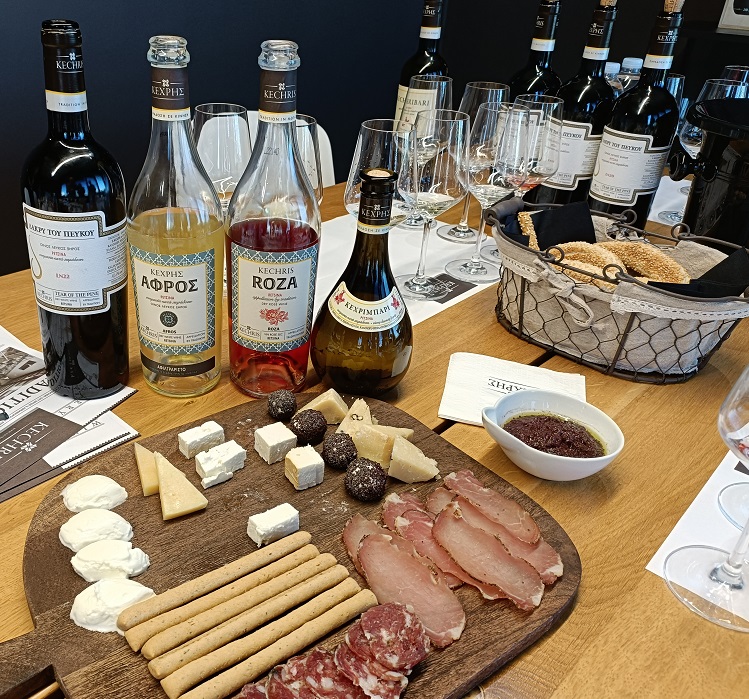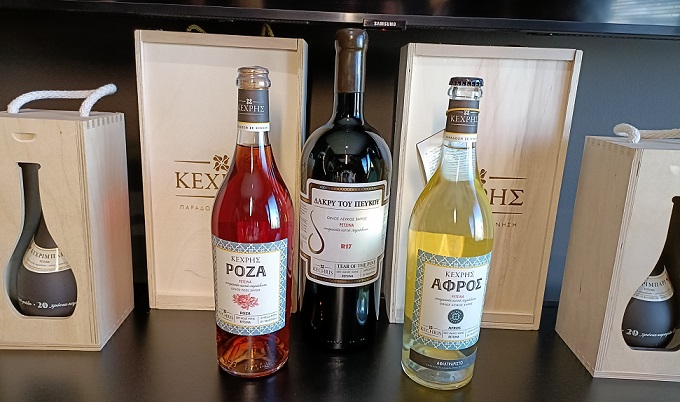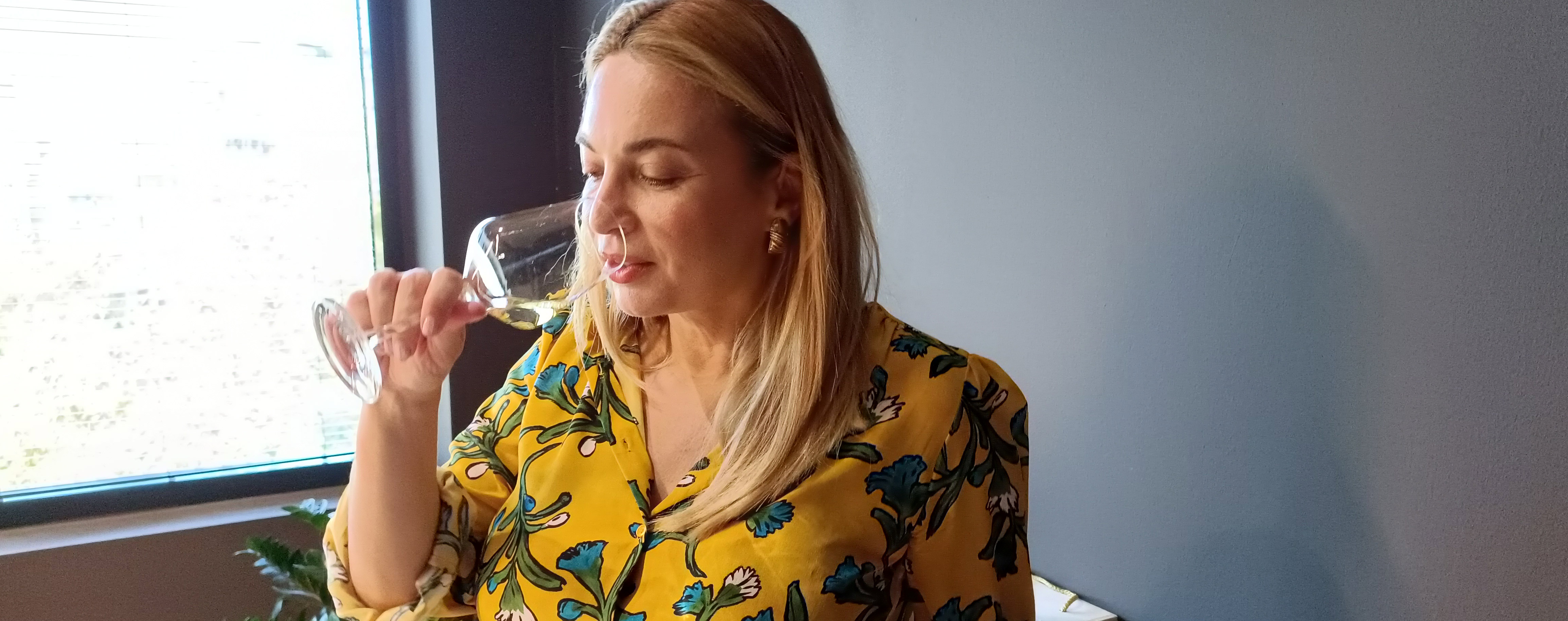She also explained that making retsina is more difficult than making a still white wine – with the quality of the resin as important as the quality of the grapes, and the correct fermentation temperature even more crucial. “You have to take care,” she said.
One problem, she outlined during our detailed conversation about making high-quality retsina, is that the ideal fermentation temperature for the must is rarely the ideal temperature for the pine resin, which is semi-solid at 30°C and almost solid at a fermentation temperature of 16°C. I clearly had a lot to learn about Greece’s much maligned creation which has been undergoing a revival in recent years.

Guiding me through the key retsinas in the Kechris range, Eleni emphasised the importance of “a good quality vinification” and stressed that the pine resin should not be added to mask poor quality wine. “It’s the same like the barrel,” she explained. “If you have bad wine and you add a lot of oak, it won’t be better – it will be worse. You have two problems – a bad wine and a lot of wood. The resin is like wood, it has an extraction: it adds aromas (like pine, sage, rosemary, mastic, ginger and spice). Both are agricultural products.”
The regulations that make the style an ‘Appellation by Tradition’ stipulate that the resin has to be added during alcoholic fermentation. “This is the most difficult thing,” Eleni continued. “You have another factor to take care of.”
Her favoured grape for retsina is Roditis. She pours the flagship Kechribari from a 500ml carafe-shaped bottle that hints at its heritage – it was launched in 1939. Kechribari was, until recently, a blend of 85% Roditis and 15% Savatiano but is now made from 100% Roditis grapes grown in northern Greece (Macedonia), on the rolling hills northwest of Thessaloniki. Eleni likes the way Roditis retains its acidity.
Vinification is in temperature-controlled tanks with a small quantity of top-quality fresh pine resin (one to 10 parts per thousand) added before the fermentation begins.
“The purpose is to drink it fresh,” Eleni said. “This is the mainstream retsina; the retsina for every day.” It pairs well with a lot of Greek and Mediterranean mezes – including garlic dishes for which it is frequently difficult to find a pairing.
As I tasted the pale-yellow wine and revelled in the aromas of pear, green apple, melon and pine, I wondered about pine resin’s reputation for being a preservative.
“We used to think that the resin is a preservative – it’s not,” Eleni corrected me. “We have made many experimentations: it is not a preservative; it is giving an aroma. Like wood gives a type of aroma, this gives the aroma of pine and sometimes herbs in some styles of resin.”
It may have gained a reputation as a preservative because, 4,000 years ago, resin was used to line and seal the amphorae during transportation and preserve it from oxidation. Ancient Greeks acquired a taste for it. Later, it was used to mask poor-quality wines. Now it is used to enhance wines and add a touch of distinction.
Eleni believes the resin aroma should be “in the background, not upfront” and that you should “smell the wine first”.

We move on to another expression of Roditis and resin: what appears to be a modern wine – a pet-nat – but Eleni says retsina in the 1970s retained a little CO2 to keep it fresh. However, today, retsina has to be a still wine.
She removes the crown cap and pours Afros (above, right), a slightly spritzy wine which borrows more from Prosecco winemaking than the ancestral method. It’s vinified in a pressurised tank for a short period to extract some resin aromas and flavours before being bottled unfiltered.
Since the 2006 vintage, there has also been a rosé version. Roza is made with 100% Xinomavro and gets its deep pink colour from 36 hours of skin contact. The alcoholic fermentation, in tanks in the presence of fresh pine resin, is followed by five months’ maturation on fine lees in oak barrels. “So, we have the third element here – a smoky barrel,” Eleni pointed out.
Regarding the extraction from the resin – or infusion really – Eleni said: “there are good things and bad things”, as there are in grape skins. “With both, you are trying to take the best parts and leave the bad.”
‘The bad’ includes the oily aromas extracted from the resin at very high temperatures and alcohol levels. “So, you only want to take the herby aromas – the aromas of the pine and sea – because then you smell Greece. That’s why retsina goes with our culture and our gastronomy.”
“To take the best,” Eleni continued, “you have to find the protocol that will take the best of the grape and simultaneously the best of the resin. That’s why retsina is difficult.”

All resins, the healing sap of the Aleppo (Pinus Halepensis) pine tree (above), are not the same. The quality depends on factors such as weather, altitude, soil, method of collection and freshness (Kechris harvests its resin at the same time as the grapes, although it’s possible to harvest from March to November). And the colour varies from white “like snow” to yellow and gold. “All these are giving different styles… Nobody has thought that the resin could be so complex,” Eleni (below) told me.

We continue the tasting with four vintages of Tear of the Pine (2022, 2020, 2019 and 2018), a retsina made from 100% Assyrtiko fermented warmer than usual (about 15°C) in a variety of oak barrels and matured for six months on fine lees. This is the retsina that changed the perception of the whole category by proving it can be a fine wine with remarkable ageing potential.
“This is the wine that I made when I came back from (studying in) Bordeaux,” Eleni said. “I used Assyrtiko which has good potential for ageing. We are making cold maceration and vinifying in barrels. We are working a lot with the lees (bâtonnage twice a week). We have here a wine which is an Assyrtiko with all the usual citrus aromas. And, in the background, we have the resin and the barrel. These two elements become more complex as time passes. So, you smell in the first note the aromas of the variety and, in the background, you have a very herby style.”
She said Assyrtiko and resin aromas “really pair very well if you work them and they’re not all over the wine but in the background. That’s why these traditions (Assyrtiko and retsina) stayed all these years, it’s not by chance. Just as the strong animal stays, so it’s the strong wine that stays. We have not decided this, we have found it and I’m working as best I can to build on it.”
Tasting Tear of Pine – a reference to the way the sap flows into containers placed under the cut bark – I’m impressed by the freshness and progression of the wines. It’s only in recent years that Elina has realised the potential for ageing as there was very little call for older wines while her father and mother, Stelios and Konstantia Kechris, were transitioning the business from a tavern to a winery in the 1950s and building it into a major producer – with an annual output of 1.5m bottles, 28-30% of which is exported to more than 20 countries.
“People couldn’t imagine that retsina can age. Even me, in the beginning – I joined in 2005 – I haven’t been vinifying for ageing; I have just replicated very good retsina in my opinion with the standards that I have learned in my studies... Now some people are beginning to try it and to taste it and to like it. Until now, everybody wanted to drink the new wines. In my opinion it is better three years later, or even five.”
I continued to taste back and forth between the vintages, reflecting that retsinas used to be very simple wines that were all about the resin. These aged wines show how complex retsinas can be. “Assyrtiko can give us this,” Eleni reminded me. “If, after you work all the resin, it’s another level.”

 English
English French
French







.png)


